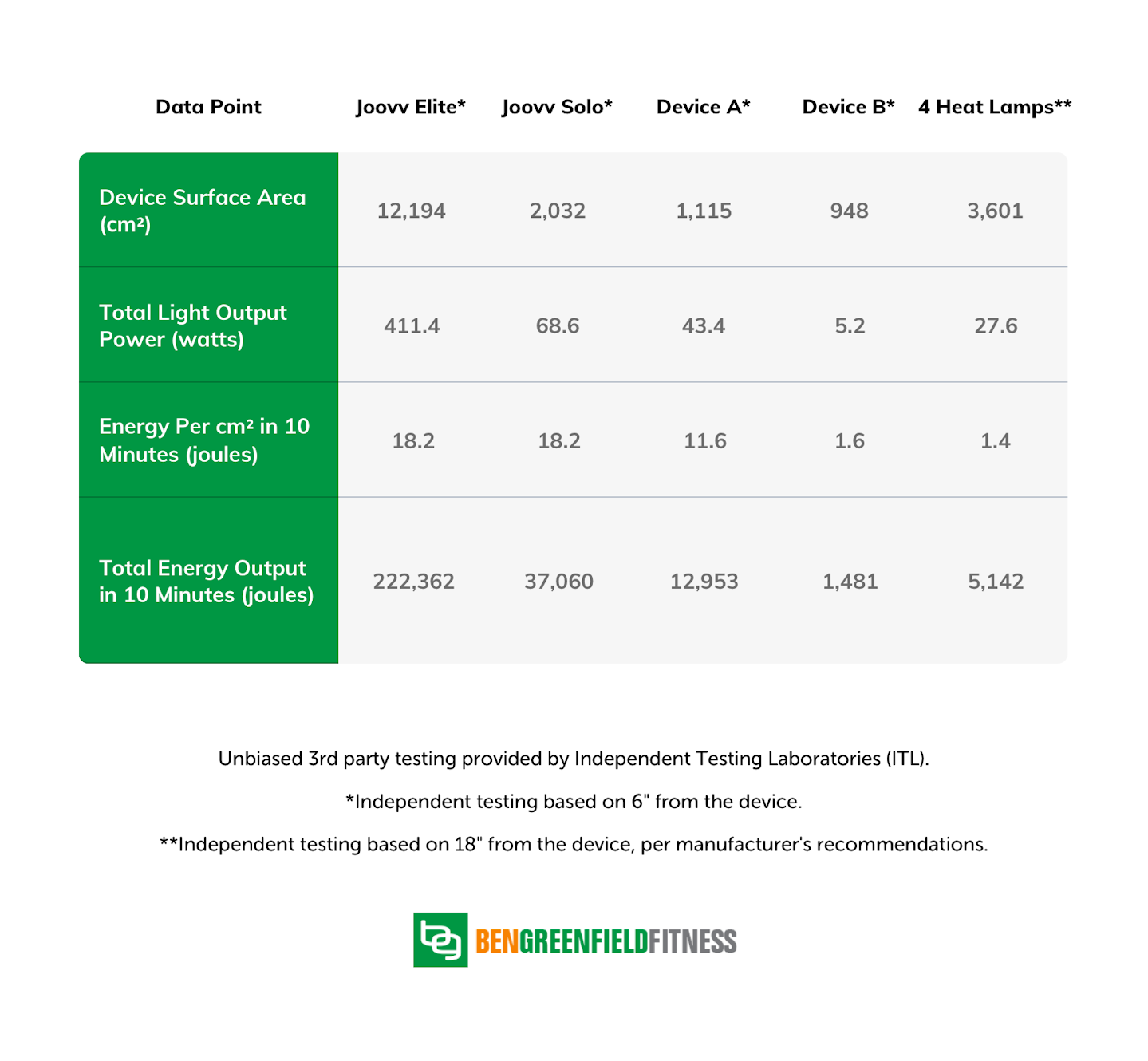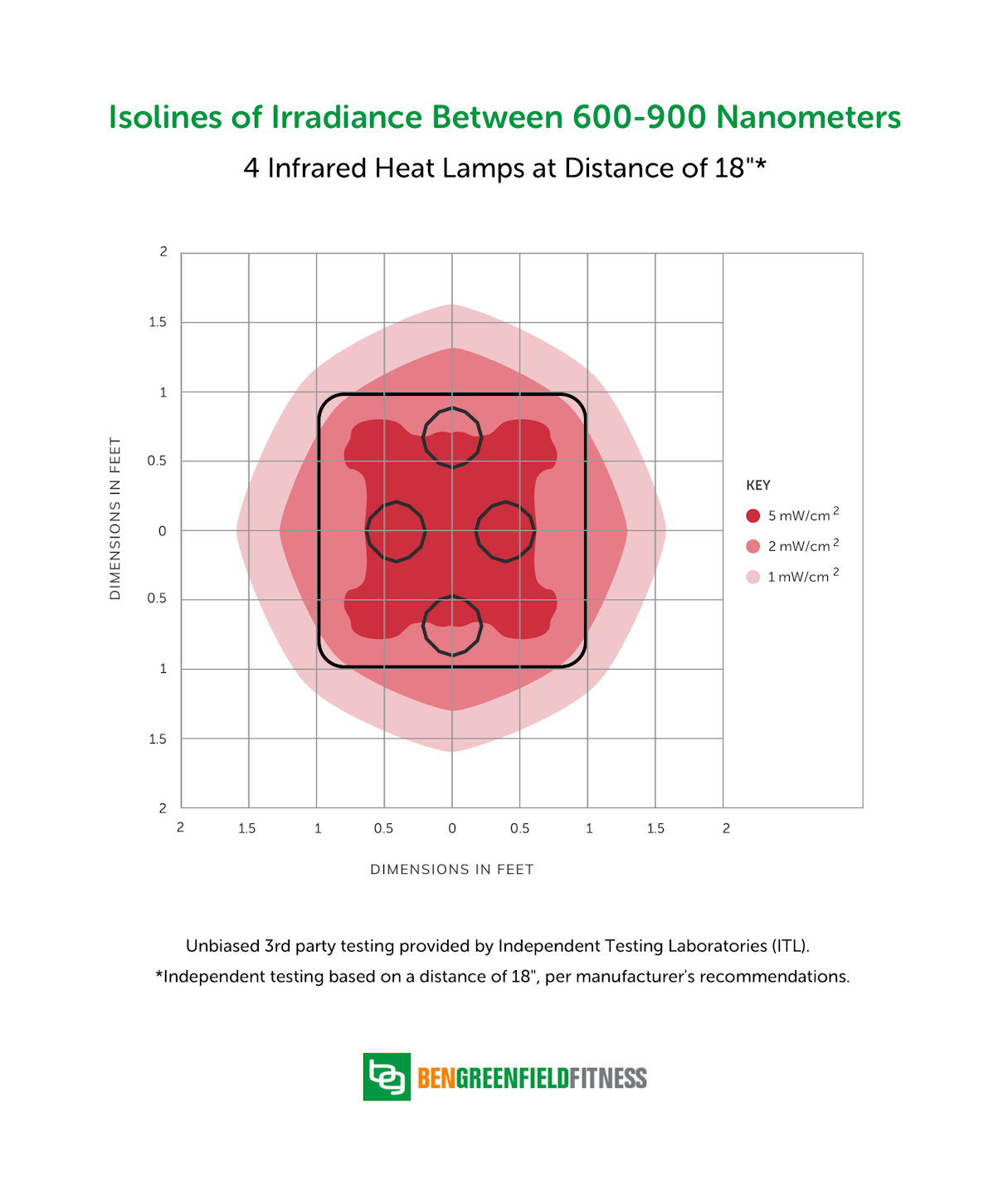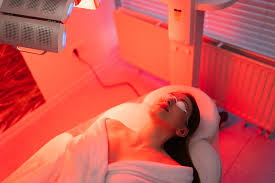Red light therapy has been steadily growing in popularity and accessibility in recent years. However, many of us are still in the dark (pun intended) about how it works, why we need it, and which products are trustworthy. This article from Bengrennfieldlife.com gives some great info on everything red light related. Enjoy the enLIGHTenment.
What’s The Deal With Fancy Red Light Devices? Your Go-To Guide On How To Use Red Light To Enhance Testosterone, Skin, Recovery, Cognition, Sleep & Beyond!

I first wrote about how you can biohack your testosterone with red light therapy in the article, “The Ultimate Guide To Biohacking Your Testosterone: 17 Ways To Maximize Muscle-Building, Drive & Anti-Aging.” This was after I’d read countless studies that found UV light increases testosterone levels when shined on your testicles.
But I’d also heard about the risks involved with exposing your balls to heat lamps and infrared light, most notably that you could potentially fry your fellas, and that’s not a risk I’m ever willing to take.
However, it turns out that, based on the research you’re about to discover, that natural red light does indeed boost testosterone, but only if you use a device with wavelengths in the 600-950 nm range. And you must also be careful not to use a device that gives off too much heat.
After learning this, I picked up a giant red light, dropped my shorts – and was blown away by the results I experienced. A year later, I even shouted to the world that, “I Put a Giant Red Light on My Balls to Triple My Testosterone Levels” in this Men’s Health article. I’ve been strategically using light therapy ever since, and you can take it from me—and my lovely wife Jessa—that it’s noticeably helped both my testosterone and sex drive and, anecdotally, many others as well. By the way, for boosting testosterone, something like red light therapy works far better when used in conjunction with other modalities like the ones I go over in “The Ultimate Guide To Biohacking Your Testosterone: 17 Ways To Maximize Muscle-Building, Drive & Anti-Aging.”
Now I don’t want to give the impression that red light therapy is just for testosterone and sex drive. The benefits of red light shine far beyond the nether regions. So in today’s article, I’m going to cover what exactly red light is, how it works, what the clinical benefits are, what to look for in a device as well as dive deeper into the science and peer-reviewed research behind light therapy, or photobiomodulation (PBM).
What is Light Therapy?
The 101 is this: light therapy—also known as photobiomodulation (PBM)—is a natural, non-invasive therapy that delivers beneficial wavelengths of light to your skin and cells. Full-spectrum light includes many colors, including wavelengths we can’t see, but only a select range of red and near-infrared light is clinically therapeutic for the purposes of PBM.
A legit light therapy device uses medical-grade LEDs to deliver clinical doses of light power to your skin, without heat, excess UV rays, drugs, chemicals, or major side effects. Red light therapy has been used in fancy spas and clinics around the world for a few decades, but only in recent years can you buy a device for your own home, and that’s been a huge game changer.
A light therapy device harnesses therapeutic wavelengths of natural light and delivers it directly to your skin. The photons of red and near-infrared react with the mitochondria in your cells, where they stimulate the electrons during cellular respiration—the process that’s responsible for all our adenosine triphosphate (ATP) production.
Here’s a bit more detail on the mechanisms at play: red and near-infrared light has a particular resonance with a key enzyme during cellular respiration—cytochrome c oxidase—or CCO for short. When our bodies are stressed or overworked, we produce a lot of nitric oxide (NO).
It’s a cool little molecule, but just like anything, too much can be a bad thing.
During cellular respiration, excess NO tends to bind with CCO, which can halt the production of ADP—adenosine diphosphate—a precursor to ATP. This is where red and NIR light comes into play. These wavelengths can sort of “excite” the electrons during oxidative phosphorylation—the last phase of cellular respiration. This, in turn, breaks the bonds between NO and CCO, resulting in normal cellular function and the eventual production of more ATP energy. Because NO is freed up at the same time, it’s also one of the reasons most people—including yours truly—feel a pump after using light therapy.
There are some secondary mechanisms at play too. Natural red and NIR light can help create a better oxidative environment in your cells, resulting in the activation of numerous intracellular signaling pathways, increased protein synthesis, enzyme activation, and enhanced cell cycle progression.
One more thought on how light therapy works: the aforementioned mechanisms are pretty well-accepted by researchers studying PBM. However, there’s still a lot we’re learning about the therapy. For example, some smart folks from Sydney University in Australia recently discovered that red and NIR light can help restore healthy gut microbiome, which suggests a different mechanism of action altogether.
At the end of the day, it’s pretty obvious that certain wavelengths of light are highly beneficial, which I’ll cover in more detail below. But it still feels like we’re on the edge of truly understanding how this all works in our bodies.
Clinically-Proven Health Benefits
One great thing about light therapy is that it’s been widely studied in clinical trials around the world for decades, starting with NASA nearly 30 years ago. In trial after trial, light therapy has been found safe and effective at promoting a wide range of pretty incredible health benefits. Now let’s geek out on some of the science.
These are some of the major areas that are backed by a large body of clinical research
Skin Health & Anti-Aging: Studies have found light therapy improves skin tone & complexion, diminishes signs of aging, speeds the healing of wounds and scars, and boosts natural collagen production. In one double-blind, placebo-controlled study, 74% of the participants reported a visible improvement in fine lines and wrinkles. Natural red and near-infrared light has also been found in clinical trials to have a therapeutic effect on the symptoms of painful skin conditions like psoriasis, herpes, and acne.
Muscle Recovery & Physical Performance: This one is my wheelhouse and the biggest reason I swear by my daily, full-body red light therapy sessions. When you train hard and perform at a high physical level, muscle recovery is essential. Red light helps my body spring back from the pain and strain of a punishing workout faster, so I can do it all over again sooner without getting hurt. Being able to train more and stay healthy is the best natural formula for gaining a competitive advantage, regardless of what sport you play. Red light not only helps you recover, but it stimulates muscle growth too. One study—from the European Journal of Applied Physiology—compared muscle growth and strength between two groups of athletes—one using light therapy combined with exercise, the other using exercise alone. Researchers demonstrated that muscle thickness and strength were significantly improved (by over 50%!) in those who used light therapy. These results were clearly measurable using ultrasound imaging and isokinetic dynamometry.
Joint Pain & Inflammation: In 2000, a systematic review in The Journal of Rheumatology set out to see just how effective light therapy could be for arthritis. This review found significant results across thirteen randomized controlled trials. The best results were demonstrated in people suffering from rheumatoid arthritis, with light therapy reducing participants’ pain by 70 percent compared to the placebo.
Increased Cognitive Function: One clinical study of men and women with a history of traumatic brain injury were administered red and NIR light therapy treatment for their brains in 18 sessions over 6 weeks. The researchers noted improved sleep, better executive functions, improved social functioning, and an increased ability to perform tasks and activities. Participants also reported improvements in depression, anxiety, headaches, and overall cognition.
Healing Wounds & Burns: Red light therapy has been shown in trials to aid the healing of wounds, burns, and scars by inducing the release of cytokines and chemokines in cells. In a 2018 study of light therapy and chronic wounds in diabetes patients, researchers found that the group treated with an LED device for 8 weeks resulted in scars with a smaller mean surface area compared to the non-LED group.
Melatonin & Sleep: I’ve mentioned many times how I’ve been sleeping better since strategically incorporating light therapy into my daily routine. Artificial light can knock your circadian rhythm out of whack, but red and near-infrared light does the opposite and helps reset your internal clock. Clinical studies show light therapy also increases natural melatonin production for healthier sleep.
What to Look for in a Light Therapy Device
Back in the day, you had to be a pretty high roller to benefit from light therapy as it was only offered in luxury spas and specialty clinics, or by medical practitioners who offered low-level laser therapy (LLLT). Thanks to the emergence of personal light therapy devices made for the home and advances in technology in the last few years, just about anyone can do it now, and word about this has been spreading like crazy in the biohacking, fitness, and natural health communities.
Choosing a device is personal; you have to make sure it’s going to meet your individual needs. Picking the best one for you can be pretty confusing though, in part because a handful of less reputable manufacturers obscure their data and make a bunch of sensational marketing claims.
To cut through the BS and make a good buy, you should think about these 4 major factors:
1. Clinically-Proven Wavelengths
The full spectrum of light is very wide and includes several colors, as well as invisible wavelengths. But all light is not beneficial. Most photomedicine researchers point to something called the “therapeutic window,” which is a range of wavelengths between about 600 to 1,200 nanometers. Red and near-infrared light—especially between 600-950 nm—has been studied extensively and its positive effects have been well documented in clinical trials.
But even within that window, for the purposes of light therapy, you want to only use devices that deliver red light in the mid-600 nm range and near infrared in the mid-800 nm range. Those are the clinical sweet spots, and pretty much all the research about light therapy is specific to these ranges of red and near-infrared light.
For example, light within the 700-770 nm hasn’t been found to have much clinical benefit, so it’s basically filler if it’s included in a light therapy device.
So obviously, stay away from companies that incorporate those wavelengths for anything other than a marketing ploy.
2. Total Delivered Power
Comparing light therapy devices by their power outputs can be confusing. Or worse, misleading. Most manufacturers list light power in terms of irradiance, which measures power per unit area, defined in milliwatts per square centimeter (mW/cm2). Irradiance (and the nature of measuring light in general) is very complex though, and unfortunately, it’s almost impossible to get an accurate reading with a home measurement tool like the Megger PVM210. Sorry DIYers, but when it comes to light therapy devices, you have to trust independent, third-party testing.
But the harsh reality is that most manufacturers don’t offer independent, verified power measurements. Those companies should be completely avoided. When a light therapy manufacturer does offer power data, it’s usually just for irradiance, which is far from the entire story. The whole point of figuring out the power of a device is to figure out how it impacts you, the human using it. An irradiance measurement alone doesn’t tell you that because it only measures the device, not what it’s delivering to your body or how much area it’s covering.
The medical researchers who run clinical trials with light therapy devices go further and take into account how much surface area is covered by the light and then control for that essential variable. That gives a far more holistic measure of total delivered power.
Dr. Michael Hamblin, a leading PBM researcher with Harvard, says it best: “Total light energy is the most accurate and comprehensive way to measure the power of light therapy devices and treatments,” says Dr. Hamblin. “If you only account for irradiance—versus how much total energy a device delivers—you miss the larger picture of how light therapy positively benefits the person using it.”
So which light therapy devices deliver the greatest total power? For your reference, the 3rd-party data in the table below is from ITL (Independent Testing Laboratories), one of the most respected photo-diagnostic companies in the world. I won’t throw their brand name under the bus, but devices A & B are LED panels that make some pretty wild marketing claims. The system on the far right is an array of four, 4 infrared heat lamps (250-watt).
 The numbers speak for themselves, but these are my key takeaways:
The numbers speak for themselves, but these are my key takeaways:
- Joovv delivers superior therapeutic power.
- Because of its size, the Joovv Elite is most effective.
- Beware of companies that make ridiculous marketing claims without the 3rd-party data to back them up. Sorry, devices A & B (heat lamps), you lose.
3. Treatment Area Size
As I mentioned above, it doesn’t make a lot of sense to think about a device’s power output without thinking about how much surface area the light covers on your body. You want to know what the device gives you, not what it can do in a vacuum.
Size matters a lot for light therapy devices because you get better results when you cover more of your body with an even distribution of light. Uniform coverage is key to optimal results, and a small device that only covers a fraction of your body simply can’t get the job done.
Targeted light therapy treatments can work well for specific areas like a scar, inflamed ankle, and yes, your balls. If you just want to shine a smaller device on your nether region every day, I’m certainly not going to stop you. Plus,you’re likely to see a rise in your testosterone and sex drive. But for the full range of benefits, you need to experience full-body treatment.
I’ll get to all the reasons why I prefer Joovv in a bit, but one of the biggest reasons is their modular design. Sort of like LEGO blocks, you can start with one of their smaller configurations—like the Joovv Solo—and then build out a full-body system over time. Or, if you’re like me and you want optimal results right away, you can choose something like the Joovv Elite right of the gate. I’m a good-sized guy, and that unit literally treats my entire eody from head-to-toe and side-to-side.
If you’re not convinced that full-body light therapy is the way to go, check out some of the graphs below (again, this 3rd-party data comes from ITL). As you can see, at about 12” from device A, the irradiance of 1 mW/cm2 is extremely low. Below that you’ll find a similar graph for a setup of 4, 250-watt infrared heat lamps. You need to be at least 18” away from those things (they get super hot!)—but at that distance—the irradiance again is only about 1 mW/cm2. With this type of power, you’re going to need hours to receive a meaningful dose of energy. Who has that much time every day? (Side note: I didn’t even include a graph for device B because it’s such a joke.)


So here’s the deal: the total energy your body receives—which is the most important data point—is a direct function of three things:
- The quality of the source. Cheap LED devices and NIR heat lamps are extremely inefficient.
- The distance you are from the device. The farther you are, the less energy dose you’ll receive.
- The size of the device. If you’re after full-body light therapy (which you should be), you’ll need a full-body device.
4. Cleared by the FDA
You only get one body and one pair of balls, so safety first. Before buying a device, make sure the production process has been cleared by the Food and Drug Administration (FDA). This is an important distinction for photobiomodulation devices in particular because Class II FDA clearance requires a light therapy manufacturer to pass rigorous safety & quality tests for every component part that makes up a device. Maintaining a robust quality management system to monitor product performance is also part of the process too. The FDA go-ahead also makes it easier to use in clinical trials, where the medical science community further evaluates and tests the product.
Bottom line: if a light therapy device isn’t cleared by the FDA, I’d stay away.
Light Therapy FAQs
Because I’ve become one of the posterboys for light therapy, so to speak, as you can imagine I get a lot of questions (and hear a lot of misconceptions) about light therapy over and over. Here are some answers to some of the more common ones I hear on a weekly basis:
Is light therapy safe? Are there side effects? Can you do too much?
First, with an FDA-cleared device, it’s safe and comes with little to no side effects. And I’m not the only one that thinks this. A major 2013 study by Harvard and MIT researchers praised light therapy for its “noninvasive nature and almost complete absence of side effects.”
Regarding overuse, you can overdo just about anything that’s good for you, but it’s hard to get too much light therapy. I stick to 20-minute treatment sessions because the body of scientific literature says that particular energy dose is optimal and safe. But even if you did more, it’s hard to imagine a lot of negative effects. At a reasonable latitude, basking naked in the sun in all your glory, you’ll receive about 1 million joules of full spectrum light in about 1 hour. That’s a lot! By comparison, at a distance of about 6”, I get about 200,000 joules of red and NIR light standing in front of my Joovv for 10 minutes.
What do you do with a light therapy device and where do you use it?
You don’t have to do a whole lot. Just stand or sit in front of a high-quality device for 10-20 minutes a day (yes, you should be naked). I usually work or answer emails, but sometimes I get a little more meditative while the red and NIR light shines over my whole body.
You can do it anywhere you want. I Joovv in my office so I feel rejuvenated ahead of the work day. But there’s no wrong place to do it as long as you do it regularly. Some people hang their Joovv on a door, others mount it on a wall or use a mobile stand to get their red light wherever. A lot of people I talk to use it in their bathroom, or even in their workout area.
Is light therapy different from heat lamps?
Yes, and the answer is right in the name: heat. High-quality LED light therapy devices give off very little heat, and as I’ve written about before, heat can be bad news for your testicles and testosterone. Heat lamps simply don’t offer the clinically-proven wavelengths and total power output of a good LED light therapy device. For more specifics, check out the table and graph I included above.
Is LED flicker an issue?
Short answer: no, not with a high-quality LED light therapy device. But if you go with a bargain option, it might be.
Long answer: I’ve previously written that LED flicker can be a bad thing. But it largely comes down to these 3 factors:
- Cheap LEDs that you can pick up at the local Lowes or Home Depot may have a significant flicker rate, which can lead to eye strain, fatigue, and other uncool side effects. Stay away.
- The LEDs I mentioned above emit a lot of blue light. And if you know me, I’m not a fan of blue light after sunset. It disrupts your circadian rhythm, which impacts pretty much everything we do, especially sleep.
- If you get a cheap light therapy device without verified data and safety, all bets are off. But if you go with a high-quality light therapy product like a Joovv, you can trust that the flicker percentages are not just extremely low, but they’ve been tested by independent, 3rd-party sources.
What about EMFs?
There’s still a lot that we don’t know about EMFs and how they affect our health. But here’s my 5-second take, which I cover more in depth in the podcast “The Non-Tinfoil Guide to EMFs: How to Fix Our Stupid Use of Technology“. Basically, less than 100 years ago, our ancestors didn’t have to deal with things like EMFs. And with modern-day technology, you can’t reasonably expect that our biological systems can adapt that fast. So obviously, I try to minimize my exposure as much as possible.
So I did my homework on the Joovv and their design. Here’s what I found:
- Every LED driver inside a Joovv is encased in aluminum, which acts as a natural shield to EMFs.
- Power cords are notorious for emitting EMFs. Joovv actually custom-designed their power cords using 3 different manufacturing techniques to proactively minimize EMFs.
- As I mentioned before, their devices are cleared by the FDA. With that, you actually have to pass EMF testing. One more reason to go with a device that’s passed the FDA sniff test.
Summary
I’m always science-first, and the clinical research on light therapy is very convincing, for both effectiveness and safety. But ultimately I talk about light therapy so much because of what I’ve felt personally, and what I’ve seen in my friends and fitness colleagues. Since I started incorporating Joovv into my daily routine, I have more energy and testosterone, I recover from workouts faster, I sleep better, my skin is healthier, I feel positive and motivated after my treatments, and I can hit the work day running. Whether you’re looking for systemic benefits like weight management, sleep, testosterone and muscle building, or just trying to rehab from an injury or get a cosmetic skin boost, I highly recommend red and near-infrared light therapy, especially the full-body kind.
I can’t recommend a Joovv more highly.
- Joovv is a science-first company that puts a huge amount of its resources towards education, service, and independent testing.
- Joovv is the only manufacturer with a modular design that lets you build a full-body system now—or over time. Coverage is key, and Joovv offers the industry’s biggest treatment area sizes at the most affordable prices.
- Joovv uses electrostatic-coated LEDs in their devices, which limits a lot of the energy loss you might see in shoddier PBM products. That means medical-grade power during shorter treatment times.
- Joovv gives me the option of switching between red and NIR light. Sometimes I like to be able to choose between the two if I’m after superficial or deep-tissue treatment.
- I trust Joovv’s manufacturing process. They’ve been cleared by the FDA, they minimize EMFs and flicker as much as possible, and I don’t feel any side effects from using it every day.
- The Joovv Go is a handy new travel device that’s just as powerful as the larger ones, but fits in the palm of your hand. It’s wireless and rechargeable too. I travel a ton, and this little guy is a game changer.
So if you’re going to get a red light, you should, in my opinion, go with the Joovv. Here’s how to get one:
Just go to BenGreenfieldFitness.com/Joovv If you enter code: BEN at checkout, you’ll receive a free gift with purchase.


